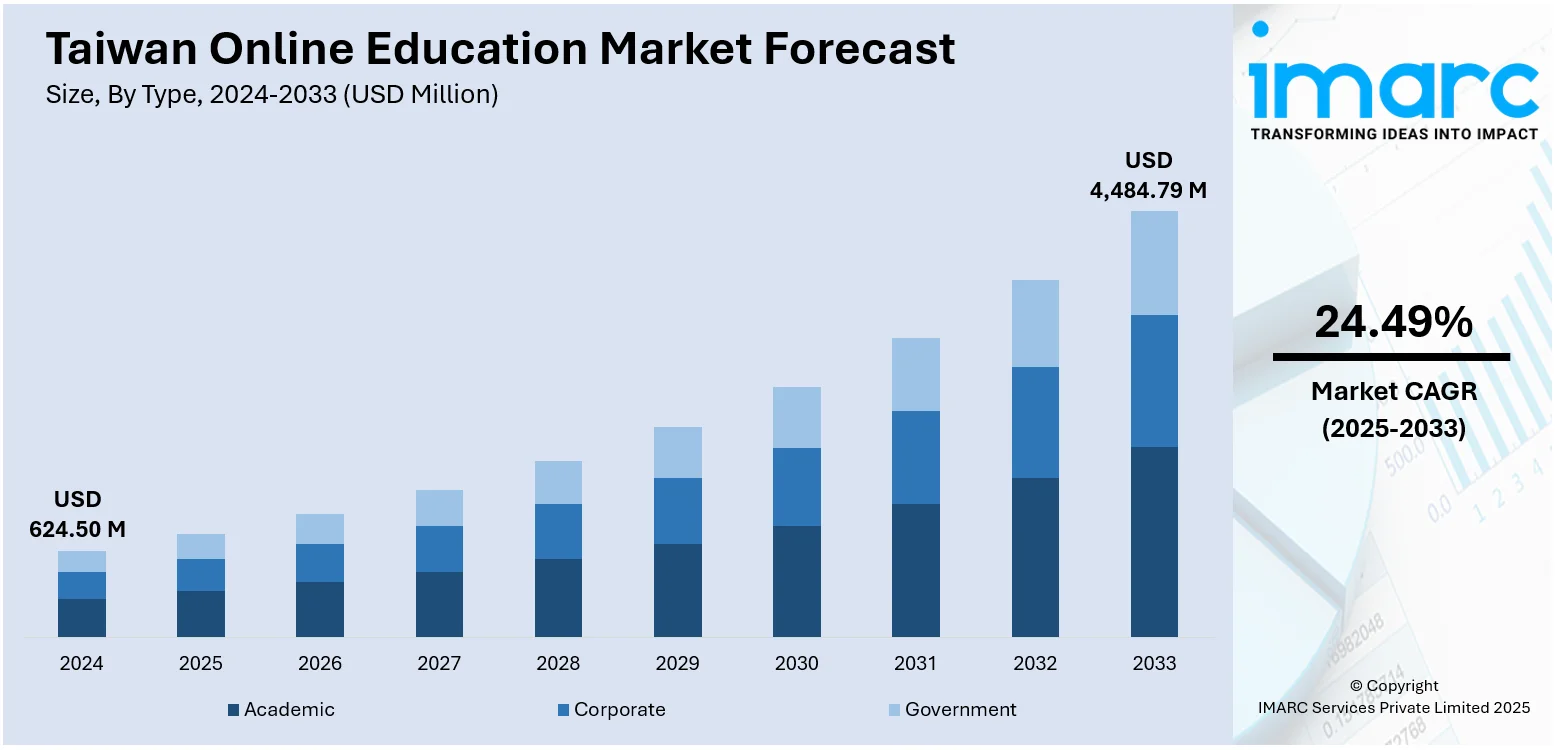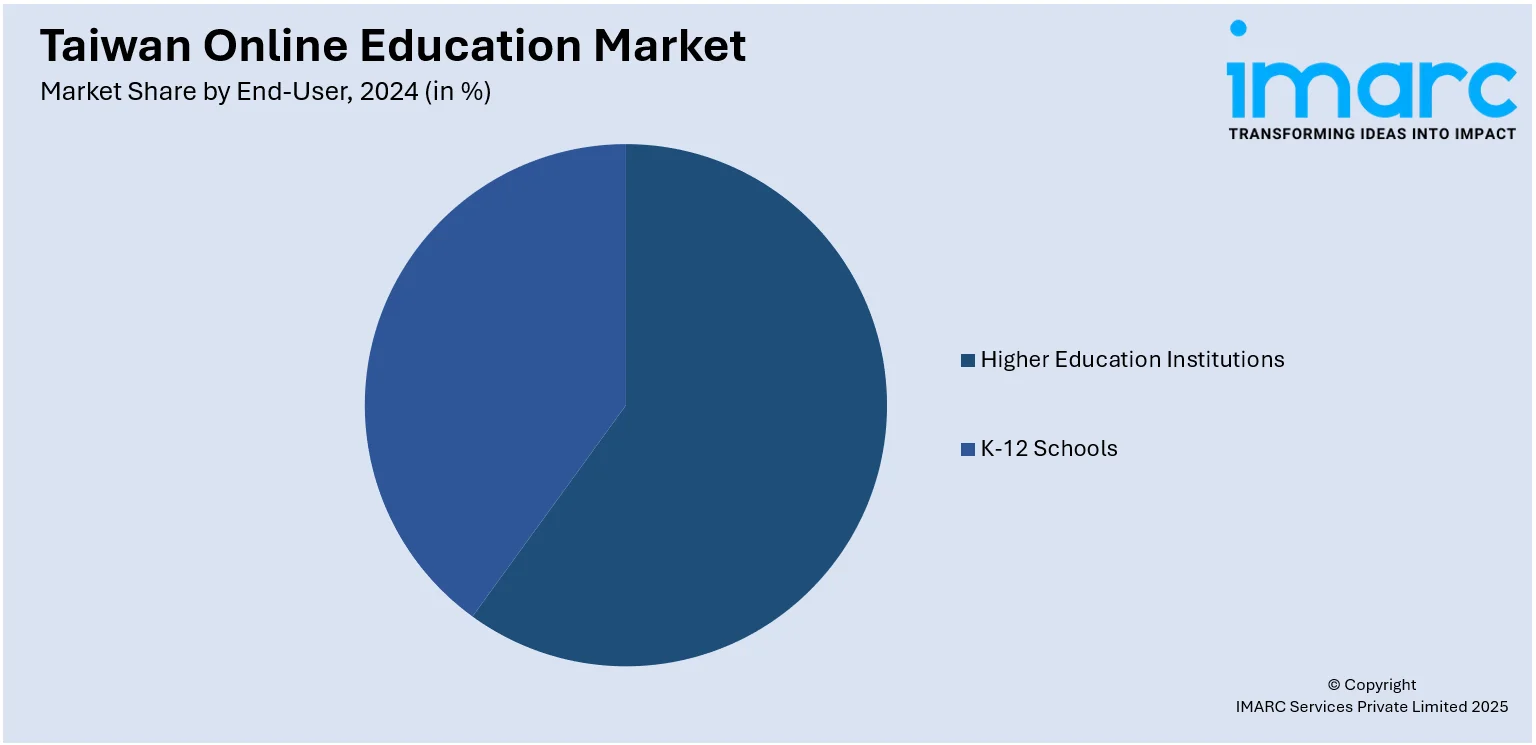
Taiwan Online Education Market Size, Share, Trends and Forecast by Type, Provider, Technology, End-User, and Region, 2025-2033
Taiwan Online Education Market Overview:
The Taiwan online education market size reached USD 624.50 Million in 2024. The market is projected to reach USD 4,484.79 Million by 2033, exhibiting a growth rate (CAGR) of 24.49% during 2025-2033. At present, rising adoption of artificial intelligence (AI)-based solutions that provide personalized content and instant feedback by analyzing student behavior, learning preferences, and speed is offering a favorable market outlook. Besides this, increasing government support to improve education access is contributing to the expansion of the Taiwan online education market share.
|
Report Attribute
|
Key Statistics
|
|---|---|
|
Base Year
|
2024 |
|
Forecast Years
|
2025-2033
|
|
Historical Years
|
2019-2024
|
| Market Size in 2024 | USD 624.50 Million |
| Market Forecast in 2033 | USD 4,484.79 Million |
| Market Growth Rate 2025-2033 | 24.49% |
Taiwan Online Education Market Trends:
Rising utilization of AI
Increasing use of AI is positively influencing the market in Taiwan. The NCC’s Communications Market Report indicated that 52.5% of respondents claimed they utilized AI services in 2024. AI-based platforms evaluate student preferences, behavior, and learning speed to provide personalized content and real-time feedback. Students are better able to understand concepts and progress at their own pace. By automating administrative tasks like attendance monitoring and grading, AI assists teachers and frees up more time for instruction. Chatbots and virtual assistants enabled by AI offer instant support to students, answering questions and guiding them through the learning process. In Taiwan, where digital adoption is strong, AI tools enhance the overall quality of online education by offering interactive features, such as speech recognition, adaptive assessments, and smart content recommendations. AI also assists in tracking academic progress and predicting learning outcomes, allowing timely interventions for struggling students. As institutions continue to employ AI technologies, the learning experience is becoming more dynamic and efficient. This leads to greater satisfaction among students and parents, encouraging more enrollment in online programs. The growing role of AI is not only improving learning outcomes but also strengthening Taiwan’s position as a forward-looking hub for digital education.

To get more information on this market, Request Sample
Increasing government support
Rising government support is impelling the Taiwan online education market growth. The government is investing in building digital infrastructure and offering financial support to schools and institutions for adopting online teaching tools. It is launching national programs to train teachers in digital methods and encouraging the development of numerous educational platforms. In February 2025, the Ministry of Education unveiled the 2025 Advanced Interdisciplinary Project in Taipei City to develop talent and advance digital education in elementary and high schools, aiming to boost Taiwan’s smart nation goals. The ministry stated that 56 schools across the country were set to participate in the initiative. Public schools and universities are receiving resources to create and share online content, making education more inclusive across different regions. The government is also supporting policies that recognize online certifications and degrees, which is increasing the value and acceptance of digital learning. Special focus is given to integrating technology in classrooms, developing e-learning materials in local languages, and encouraging research in educational technology. These efforts help bridge the gap between urban and rural education and make learning more flexible and engaging.
Taiwan Online Education Market Segmentation:
IMARC Group provides an analysis of the key trends in each segment of the market, along with forecasts at the country and regional levels for 2025-2033. Our report has categorized the market based on type, provider, technology, and end-user.
Type Insights:
- Academic
- Higher Education
- Vocational Training
- K-12 Education
- Corporate
- Large Enterprises
- SMBs
- Government
The report has provided a detailed breakup and analysis of the market based on the type. This includes academic (higher education, vocational training, and K-12 education), corporate (large enterprises and SMBs), and government.
Provider Insights:
- Content
- Services
A detailed breakup and analysis of the market based on the provider have also been provided in the report. This includes content and services.
Technology Insights:
- Mobile E-Learning
- Rapid E-Learning
- Virtual Classroom
- Others
The report has provided a detailed breakup and analysis of the market based on the technology. This includes mobile e-learning, rapid e-learning, virtual classroom, and others.
End-User Insights:

- Higher Education Institutions
- K-12 Schools
A detailed breakup and analysis of the market based on the end-user have also been provided in the report. This includes higher education institutions and K-12 schools.
Regional Insights:
- Northern Taiwan
- Central Taiwan
- Southern Taiwan
- Eastern Taiwan
The report has also provided a comprehensive analysis of all the major regional markets, which include Northern Taiwan, Central Taiwan, Southern Taiwan, and Eastern Taiwan.
Competitive Landscape:
The market research report has also provided a comprehensive analysis of the competitive landscape. Competitive analysis such as market structure, key player positioning, top winning strategies, competitive dashboard, and company evaluation quadrant has been covered in the report. Also, detailed profiles of all major companies have been provided.
Taiwan Online Education Market News:
- In May 2025, the Ministry of Foreign Affairs announced interministerial initiatives to train and hire foreign workers with essential skills to boost national economic competitiveness. The ministries aimed to create education-training-employment pathways via online classrooms, cooperative education, and scholarships in supportive countries.
- In September 2024, Taiwan’s Ministry of Education (MOE) initiated a program to incorporate AI into its education systems for elementary and middle schools. According to Deputy Minister of Education Yeh Ping-cheng, this initiative was a component of a larger plan to position Taiwan as a frontrunner in AI education throughout Asia within the coming two years. It demonstrated Taiwan's increasing dedication to enhancing digital literacy and equipping students for future employment in a tech-focused environment. To guarantee fair access to these courses, Tsai and Chang created an online platform that assessed students’ program codes, enabling distance learning and providing quality AI education to learners in urban and rural areas.
Taiwan Online Education Market Report Coverage:
| Report Features | Details |
|---|---|
| Base Year of the Analysis | 2024 |
| Historical Period | 2019-2024 |
| Forecast Period | 2025-2033 |
| Units | Million USD |
| Scope of the Report |
Exploration of Historical Trends and Market Outlook, Industry Catalysts and Challenges, Segment-Wise Historical and Future Market Assessment:
|
| Types Covered |
|
| Providers Covered | Content, Services |
| Technologies Covered | Mobile E-Learning, Rapid E-Learning, Virtual Classroom, Others |
| End-Users Covered | Higher Education Institutions, K-12 Schools |
| Regions Covered | Northern Taiwan, Central Taiwan, Southern Taiwan, Eastern Taiwan |
| Customization Scope | 10% Free Customization |
| Post-Sale Analyst Support | 10-12 Weeks |
| Delivery Format | PDF and Excel through Email (We can also provide the editable version of the report in PPT/Word format on special request) |
Key Questions Answered in This Report:
- How has the Taiwan online education market performed so far and how will it perform in the coming years?
- What is the breakup of the Taiwan online education market on the basis of type?
- What is the breakup of the Taiwan online education market on the basis of provider?
- What is the breakup of the Taiwan online education market on the basis of technology?
- What is the breakup of the Taiwan online education market on the basis of end-user?
- What is the breakup of the Taiwan online education market on the basis of region?
- What are the various stages in the value chain of the Taiwan online education market?
- What are the key driving factors and challenges in the Taiwan online education market?
- What is the structure of the Taiwan online education market and who are the key players?
- What is the degree of competition in the Taiwan online education market?
Key Benefits for Stakeholders:
- IMARC’s industry report offers a comprehensive quantitative analysis of various market segments, historical and current market trends, market forecasts, and dynamics of the Taiwan online education market from 2019-2033.
- The research report provides the latest information on the market drivers, challenges, and opportunities in the Taiwan online education market.
- Porter's five forces analysis assist stakeholders in assessing the impact of new entrants, competitive rivalry, supplier power, buyer power, and the threat of substitution. It helps stakeholders to analyze the level of competition within the Taiwan online education industry and its attractiveness.
- Competitive landscape allows stakeholders to understand their competitive environment and provides an insight into the current positions of key players in the market.
Need more help?
- Speak to our experienced analysts for insights on the current market scenarios.
- Include additional segments and countries to customize the report as per your requirement.
- Gain an unparalleled competitive advantage in your domain by understanding how to utilize the report and positively impacting your operations and revenue.
- For further assistance, please connect with our analysts.
 Request Customization
Request Customization
 Speak to an Analyst
Speak to an Analyst
 Request Brochure
Request Brochure
 Inquire Before Buying
Inquire Before Buying




.webp)




.webp)












